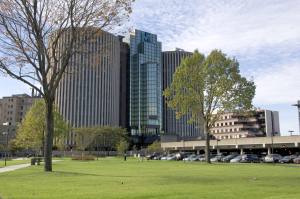By Kelley Kauffman, MSN, APRN-CNP, PMHNP-BC, Center for Health Equity Engagement Education and Research
We can no longer deny the flaws within America’s health care system. They have been highlighted and exploited by the coronavirus pandemic and people are dying as a result. Our decentralized healthcare system has not been able to respond quickly enough to this stealthy virus. The US has fewer hospital beds, doctors, and nurses per capita than other developed nations. Millions are uninsured or underinsured, receiving hospital bills for COVID-19 treatments totaling more than $30,000. Of course, these problems are not the only reason more than three quarters of a million people in the US have contracted COVID-19 and nearly 50,000 have died; However, it has made America especially vulnerable to the spread of the pathogen. /cdn.vox-cdn.com/uploads/chorus_image/image/66655090/GettyImages_1217646938.0.jpg)
We continually hear from our leaders and the media that we are in a battle or war against an invisible contagion. Stay-at-home orders are passed, the national guard is mobilized to help care for the overflow of sick and dying. The author of this Vox article reminds us that historically, wars have led to reconstruction and progress. But is the coronavirus disruptive enough to force the changes needed in the healthcare system? Is it enough to bring our country together around the idea of universal, government guaranteed health care? Only time will answer that but there are some impacts of the pandemic that will leave an indelible mark on the US health care system for years to come. Vulnerable hospitals are being drained of their reserves, patients are embracing telehealth care from the safety of home, and the government is desperately trying to patch holes in America’s safety net.
The article describes in detail several changes to the health care system that are well underway.
- Some hospitals will probably close. A lot of primary care doctors could also be in trouble.
- Many hospitals are dependent on the outpatient services and elective surgeries that have been canceled during the pandemic causing some to run out of cash reserves. 1 out of 4 rural hospitals were already vulnerable to closure before COVID-19 reached the US. Congress is sending money to hospitals and elective surgeries will be getting back up and running soon. But it still might be too late to save some of these hospitals producing an even greater barrier to patients seeking to access care.
- Independent primary care clinics face similar financial hardships as many patients are not coming in for routine health check-ups.
- Telemedicine will go mainstream
- Telehealth visits surged by 50% in March as social distancing measures went into full effect, and the total number of phone or video interactions is expected to exceed 1 billion by year’s end. In contrast, last year, only about one in 10 Americans were taking advantage of telehealth services (partially due to lack of insurance coverage, greater comfort with “hands on” medicine, reduced reimbursement rates, etc.).
- People have become more comfortable with these virtual encounters for routine problems. But for a permanent shift, insurance companies will have to commit to continuing to cover telemedicine as they are now.
- We’ll invest more in public health preparedness and surveillance
- Budget cuts to the Centers for Disease Control and other related surveillance programs that monitor outbreaks around the world made it harder for the US to anticipate the coming crisis and develop a response plan. Public health tends to be first on the chopping block when cuts are made in Congress. But outbreaks tend to stimulate funding for public health. The hope is that there will now be lasting investments in public health, at least until the pandemic fades from our collective memory and the immediacy of threat no longer forces the need for public health funding.
- Rethinking how drugmakers and the federal government handle urgent needs
- When COVID-19 appeared as a worldwide threat, the race to find vaccines and treatments was triggered. But antiviral research investment, prior to COVID-19, has not been a priority for the major drugmakers whose participation is necessary for the mass production of any new medication. Pfizer’s antiviral research department (disbanded in 2009) had to be reestablished for its COVID-19 work. Novartis had ended its antiviral and antibacterial research in 2018. The economic incentives of antibiotics and antivirals for these companies have just not been significant enough to justify research and development in this area.
- The pandemic may cause the FDA and/or Congress to step in to encourage, promote, and/or require drug manufacturers to research and produce drugs of high public health value, with relatively lower market value, in an emergency.
- There will be a push to expand health coverage
- Before the crisis, more than 10% of Americans were uninsured. That number is now significantly higher after millions have lost their jobs and employer provided health insurance along with it.
- Many of the largest coverage expansions both in the US and in similar countries occurred during times of upheaval, whether from war, social unrest, or financial crises. One theory for this is the increased sense of social solidarity created by crisis events. The longer the crisis lasts, the more likely that changes to social solidarity will be solidified. However, the fact remains that any significant expansion of health coverage in the US will still likely depend on the outcome of the 2020 presidential election.
Again, only time can reveal the true long-term effects the pandemic will have on our healthcare system. Humans, collectively, tend to have short attention spans. Will this pandemic last long enough to make such a significant impact on our lives we won’t be able to forget it or its effects for years, decades, even longer? The answer is that we just don’t know yet. But there are signs, that at least in these 5 areas, the pandemic will have lasting impacts on the US healthcare system for years to come.
Reference
Scott, D. How the COVID-19 pandemic will leave its mark on US health care: From hospital closures to the rise of telehealth, these are 5 ways the system is already beginning to transform. Vox. April 22, 2020.

